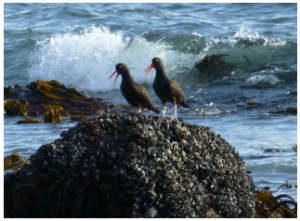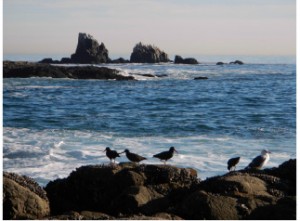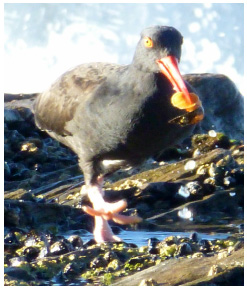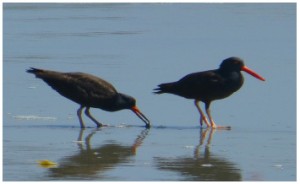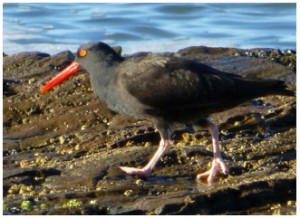BOUNTIFUL, BEAUTIFUL BLOY!
BOUNTIFUL, BEAUTIFUL BLOY!
Over the years we have seen Black Oyster Catchers (BLOY) from Dana Point in the south to Crystal Cove in the north, wherever there are healthy mussel beds and rocky ledges. Often YOU CAN hear them FIRST, calling to each other with a very distinct and plaintiff cry. It is a wild and haunting sound which carries above the surf. Knowing they are close by is good enough for us, we do not have to see them. They cry hew, hew, hew when alarmed but seem comfortable around low-profile rock scramblers like us.
Sometimes, you can find their nest, sometimes not – it can be totally inaccessible. They make a small, inconspicuous scrape in the rock face and wedge their nest in tightly. They have been nesting on our rocky shores for the past 4 years at least – that we know. Two chicks show up in the nest in June/July and they are off flying within 40 days of birth.

Adult BLOY bringing food to two BLOY chicks on their protected rocky ledge- these chicks are not flying yet. Sandy swam out to this location and took this photo from the water.
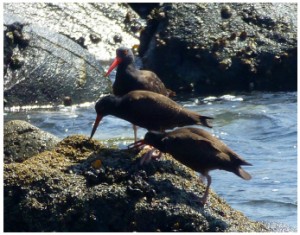
Adult BLOY (solid bright red bill) presenting a limpet to two BLOY chicks (bi-colored black and red bills). These chicks have fledged from the nest site and are nearly the size of their parents but are still dependent on them for much of their food.
The Laguna Bluebelt’s rocky coves covered with healthy mussel beds on intertidal rocky ledges (the intertidal zone) provide excellent habitat for BLOY. They will eat oysters when given the opportunity but they mostly eat mussels, limpets, chitons, crabs and barnacles. They hunt through the intertidal area, searching for food visually, often so close to the water’s edge they have to fly up to avoid crashing surf.
They use their strong red bills to dislodge food and pry shells open. They also forage on the beach. They are very clever!
A few interesting facts:
- A group of Black Oystercatchers are called A Parcel.
- Just take a look at a Black Oystercatcher’s eye – it looks like a bull’s eye.
- And how about that thick red mollusk-cracking bill? Amazing!
- The Black Oystercatcher can live for more than 15 years – a goodly time for a shorebird.
- Black Oystercatchers are found along rocky shores from Alaska to Baja California.
For the past five years Charlotte Masarik, Sandy Dildine and others have been monitoring Black Oystercatchers (BLOY) and all shorebirds along the beautiful Laguna Coast as part of Laguna Ocean Foundation’s quarterly Shorebird Survey.
If you would like to participate in this all-volunteer survey, contact us at charlotte@lagunabluebelt.org; or contact the survey’s coordinator, Ed Almanza, at superpark@igc.org. You can also contact Laguna Ocean Foundation directly at lagunaoceanfoundation@gmail.com.

